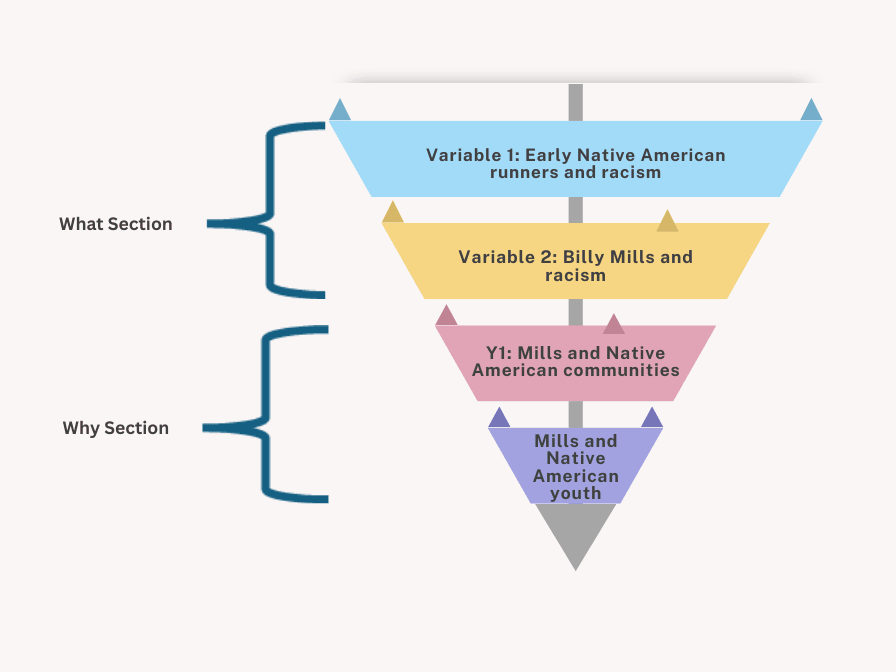LESSON 5.19
Research & Write New Variable

Variable 2
Variable 1 of our sample essay was about racism and early Native American runners. It is a New idea because it is highly likely to be new and interesting to educated American adults.
Variable 2 is more specific than Variable 1. It deals with the racism involving only one runner, Billy Mills. As a diagram, the result looks like this:
The diagram looks like you are peering down a funnel. We use the funnel image a lot in GWS, so let’s examine it from the side:
Task 5.19.1 – Individual or Tandem
The following are times of racism associated with Billy Mills or the Lakota. They are in alphabetical order.
Life in Pine Ridge Reservation during Mills’s youth
Native American Boarding Schools
Racism Specific to Mills
The Wounded Knee Massacre
Decide which of the following organizations would be best:
Alphabetical
Chronological
General to specific
Spatial (logical description)
Place the subjects above in the pattern you feel is best.
Claim
Start the Variable 2 section with a Claim. Remember, it is an arguable statement that summarizes the section. The Variable 2 Claim should refer to both the Variable 1 subject and to the Variable 2 subject.
Task 5.19.2 – Tandem or Small Group
Which of the following is the best Claim for Variable 2? Why?
- Billy Mills, a Lakota long-distance runner who made one of the greatest upsets in Olympic history, also experienced racism.
- Billy Milly was a Lakota long-distance runner who made one of the greatest upsets in Olympic history.
- Later Native American runners also experienced racism.
- Boarding schools were set up to assimilate Native Americans into White culture.
Part D of IDP for Variable 2:
Define, Describe, and/or Discuss
As you have learned, sections of a document usually follow this pattern:
I – Introduce the section, usually with a Claim.
D – Define, describe, and/or discuss the Claim.
P – Provide evidence that the Claim is true.
Task 15.9.3 – Individual or Tandem
Next, write a short paragraph defining, describing, and/or discussing the Claim. Finish the Part D by listing the parts of Variable 2 from Task 5.19.2. List them in order. You can do that as a list in a text or as bullets.
To form bullets, click on the uppermost left-hand corner above “Paragraph” in “Home” in the main toolbar.
Levels
To make reading easier, most writers divide documents into levels, also known as headings and subheadings. In this lesson, we are going to learn Levels 1-3. Each level must follow a certain set of rules.
All headings are 12 pt.
All headings are boldfaced.
The first word and all major words are capitalized.
There are no extra spaces above or below a level.
There is no period for Levels 1-3.
Level One
Start typing the text on the next line. Indent the first line of the text. Make sure you chage the line from centered to left-aligned. Do that by clicking the leftmost box of the four boxes above Paragraph in Home.
Level Two
Start typing the text on the next line. Indent the first line of the text.
Level Three
Same as Level Two, except that the heading is italicized.
Task 15.9.4 –Tandem or Small Group
Return to Variable 1.
A. Create a Level 1 heading that says Background
B. Create a Level 2 heading that says Lewis “Deerfoot” Bennett
C. Create a second Level 2 heading that says Tom Longboat
D. Create a third level 2 heading that says Jim Thorpe
Below Variable 1, add the following for Variable 2:
E. Create another Level 1 heading that says Billy Mills
F. Place the text from Task 5.19.2 and 5.19.3 below the Level 1 heading. You can combine I and D (of IDP) into one paragraph if you wish.
G. Create a Level 2 heading for each of the subjects from Task 15.9.3. Leave lots of room between each heading.
Task 5.19.4 –Tandem or Small Group
Read the assigned parts from the articles marked “Billy Mills” in the Unit II Reference Materials subfolder. Your teacher will tell you which parts to read.
Copy and paste information under the appropriate Level 2 heading in Task 5.19.3. Put a letter below each excerpt you cut so you will remember where it came from. In the sample below, for instance, the except comes from Article A, the first article you read.
Racism Specific to Mills
Perhaps none more so than the memory of standing atop the Tokyo medal podium in October of 1964 and fighting back tears – not of joy, but from feeling unaccepted.
A
“When they played the United States national anthem, it was powerful. It was beautiful,” Mills said. “I felt emotion being a citizen of our country, but overriding that was something more powerful. I whispered to myself, ‘I don’t belong’. I came close to crying on the victory stand. People probably thought I was crying because I’d won a race. It was more powerful than that.”
A
Continue until you have enough material for a least a paragraph or two in each part.
Task 5.19.5 (Optional) –Tandem or Small Group
Locate other research materials as you or your instructor see fit.